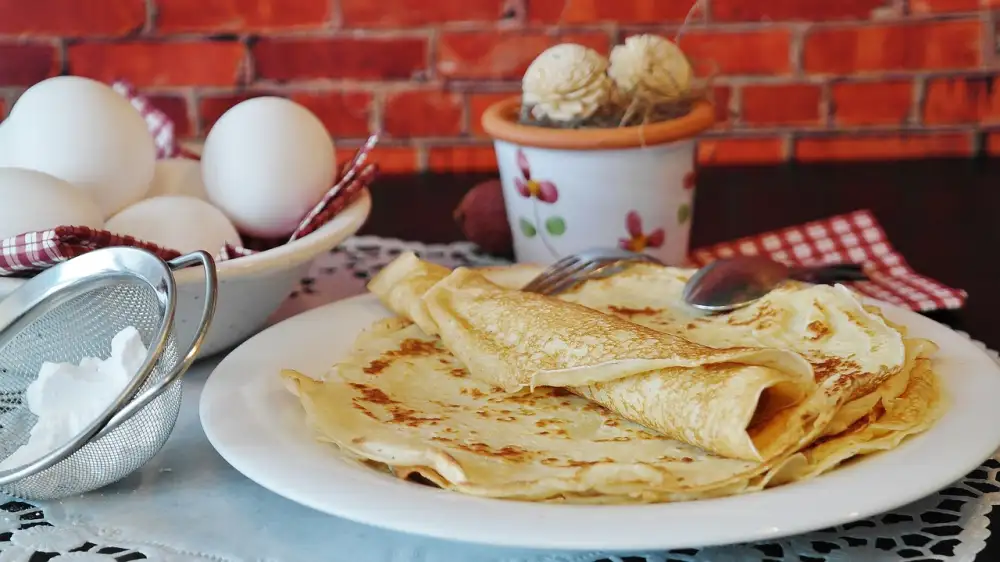Deliciously Dutch: Discover the Authentic Dutch Pancake Recipe!

Dutch Pancake, also known as Dutch Baby Pancake or Pannekoeken, is a delightful and versatile dish that has captured the hearts and taste buds of people around the world. This traditional Dutch delicacy is a cross between a pancake and a crepe, with a unique texture and flavor that sets it apart from other breakfast treats.
The Dutch Pancake is characterized by its thin and large size, often spanning the entire diameter of a frying pan. It is cooked in the oven rather than on the stovetop, resulting in a puffy and golden-brown creation that is truly irresistible. Its crispy edges and soft, custard-like center make every bite a delectable experience.
Whether enjoyed for breakfast, brunch, or even dessert, the Dutch Pancake offers endless possibilities for customization. From sweet toppings like powdered sugar, fresh fruits, or syrup to savory fillings such as cheese, bacon, or vegetables, this versatile dish can be tailored to suit any palate.
In this article, we will delve into the history and origins of Dutch Pancake, explore its traditional ingredients and step-by-step recipe for making it at home. We will also discover variations and adaptations of this classic dish, along with serving suggestions and accompaniments. Lastly, we will uncover some surprising health benefits that make indulging in Dutch Pancakes all the more enjoyable. So join us on this culinary journey as we unravel the secrets behind this deliciously Dutch delight!
History and Origins of Dutch Pancake
The history of Dutch pancakes can be traced back to the 17th century in the Netherlands. These thin and delicious treats have been a staple in Dutch cuisine for centuries. The origins of Dutch pancakes can be attributed to the Dutch tradition of making flatbreads, which eventually evolved into the pancake we know today.
In the past, Dutch pancakes were often made with buckwheat flour, as it was readily available and affordable. However, over time, wheat flour became more popular and is now commonly used in traditional recipes.
Dutch pancakes gained popularity not only in the Netherlands but also internationally. They were introduced to other countries through trade routes and colonization. Today, they are enjoyed by people all around the world.
The Dutch take great pride in their pancake heritage and have even established pancake houses or "pannenkoekenhuizen" where these delectable treats are served. These establishments offer a wide variety of toppings and fillings to satisfy every palate.
The history and origins of Dutch pancakes showcase their rich culinary heritage and how they have become a beloved dish both within the Netherlands and beyond its borders.
Traditional Ingredients Used in Dutch Pancake
The traditional Dutch pancake, known as "pannenkoeken," is a delightful culinary creation that showcases the rich flavors of the Netherlands. Made with simple yet wholesome ingredients, this pancake is a true delight for the taste buds.
The main ingredients used in a traditional Dutch pancake include flour, eggs, milk, and a pinch of salt. These basic pantry staples come together to create a thin and delicate pancake that is both light and satisfying.
Flour forms the foundation of the pancake batter, providing structure and texture. The type of flour used can vary, but most recipes call for all-purpose or plain flour. Eggs are added to bind the ingredients together and give the pancake its characteristic richness.
Milk is another essential ingredient in Dutch pancakes. It adds moisture and helps create a smooth batter consistency. Whole milk is commonly used, but some variations may incorporate buttermilk or even beer for added flavor complexity.
A pinch of salt is added to enhance the overall taste of the pancake. While it may seem like a small addition, it plays an important role in balancing the sweetness and bringing out the flavors of other ingredients.
In addition to these core ingredients, Dutch pancakes can be customized with various toppings and fillings. Popular choices include bacon, cheese, apples, raisins, or even savory options like ham or mushrooms. These additions add depth and variety to an already delicious dish.
By using these traditional ingredients in their purest form, Dutch pancakes offer a delightful combination of simplicity and flavor that has been enjoyed by generations. Whether you prefer them sweet or savory, these pancakes are sure to satisfy your cravings for authentic Dutch cuisine.
Step-by-Step Recipe for Making Dutch Pancake
1. In a mixing bowl, combine 2 cups of all-purpose flour, 2 tablespoons of sugar, and a pinch of salt.
2. Make a well in the center and crack in 4 eggs. Gradually whisk in 2 cups of milk until the batter is smooth and free of lumps.
3. Optional: For extra flavor, you can add a teaspoon of vanilla extract or a tablespoon of melted butter to the batter.
4. Preheat your oven to 425°F (220°C). Place a 12-inch cast-iron skillet or ovenproof pan in the oven to heat up.
5. Once the pan is hot, carefully remove it from the oven and add a tablespoon of butter, swirling it around to coat the bottom and sides.
6. Pour the pancake batter into the hot pan and spread it evenly using a spatula.
7. Bake for about 20 minutes or until the pancake is puffed up and golden brown on top.
8. Remove from the oven and let it cool for a few minutes before slicing into wedges.
9. Serve warm with your choice of toppings such as powdered sugar, fresh fruit, maple syrup, or even savory options like cheese or bacon.
10. Enjoy this delicious Dutch pancake with family and friends!
Variations and Adaptations of Dutch Pancake
While the traditional Dutch pancake recipe is undeniably delicious, there are also several variations and adaptations that have emerged over the years. One popular variation is the apple pancake, where thin slices of apple are added to the batter before cooking. This adds a delightful sweetness and texture to the pancake.
Another adaptation is the savory Dutch pancake, which incorporates ingredients such as cheese, bacon, or vegetables into the batter. This creates a hearty and flavorful pancake that can be enjoyed as a main course or a side dish.
For those with dietary restrictions, there are also gluten-free and vegan versions of Dutch pancakes available. These adaptations use alternative flours such as buckwheat or almond flour, and substitute dairy products with plant-based alternatives like almond milk or coconut oil.
In addition to these variations, creative cooks have experimented with different toppings and fillings for their Dutch pancakes. Some popular choices include Nutella, fresh berries, whipped cream, or even savory options like smoked salmon and cream cheese.
The versatility of Dutch pancakes allows for endless possibilities when it comes to creating unique flavors and combinations. Whether you prefer sweet or savory, traditional or modern twists, there is a Dutch pancake variation out there to satisfy every palate.
So why not get creative in your own kitchen? Experiment with different ingredients and flavors to put your own spin on this beloved Dutch dish. The result will surely be a delicious pancake experience that you won't soon forget!
Serving Suggestions and Accompaniments for Dutch Pancake
Dutch pancakes are incredibly versatile and can be served in various ways, making them suitable for any meal of the day. Here are some popular serving suggestions and accompaniments that complement the flavors of this delightful dish.
1. Sweet Toppings: The most traditional way to enjoy Dutch pancakes is with a sprinkle of powdered sugar and a squeeze of fresh lemon juice. This classic combination enhances the pancake's natural sweetness. You can also add a dollop of whipped cream or a drizzle of maple syrup for an extra touch of indulgence.
2. Fruity Delights: Fresh fruits such as strawberries, blueberries, or sliced bananas make excellent toppings for Dutch pancakes. Their vibrant colors and juicy flavors provide a refreshing contrast to the pancake's richness. You can also experiment with fruit compotes or jams to add a burst of fruity goodness.
3. Savory Options: Dutch pancakes are not limited to sweet toppings alone. For a savory twist, try adding ingredients like cheese, ham, bacon, or smoked salmon on top of your pancake. These savory additions create a satisfying balance between the pancake's light texture and the rich flavors.
4. Traditional Accompaniments: In the Netherlands, Dutch pancakes are often served with butter and stroop (a thick syrup made from sugar beets). The butter adds richness while the stroop provides a sweet and sticky contrast to the pancake's softness.
5. Creative Combinations: Don't be afraid to get creative with your toppings! Experiment with different combinations such as Nutella and sliced almonds, caramelized apples with cinnamon, or even savory options like goat cheese and arugula.
Remember that presentation plays an essential role in enhancing your dining experience. Consider stacking multiple pancakes on top of each other or rolling them up into cylinders before adding your chosen toppings.
Whether you prefer sweet or savory flavors, there is a serving suggestion or accompaniment that will suit your taste buds. The versatility of Dutch pancakes allows you to explore various combinations and create a personalized culinary experience. So, get creative in the kitchen and enjoy the deliciousness of Dutch pancakes with your favorite toppings!
Health Benefits of Dutch Pancake
While Dutch pancakes may be a delicious treat, they also offer some surprising health benefits. Made with simple and natural ingredients, these pancakes can be a nutritious addition to your diet.
Firstly, Dutch pancakes are often made with whole wheat flour, which is rich in fiber. Fiber aids digestion, helps regulate blood sugar levels, and promotes feelings of fullness, making it beneficial for weight management.
Additionally, Dutch pancakes can be topped with an array of fruits such as berries or sliced apples. These fruits provide essential vitamins, minerals, and antioxidants that support overall health. Berries are particularly known for their high antioxidant content, which helps protect the body against oxidative stress and inflammation.
Furthermore, Dutch pancakes can be served with a variety of toppings such as yogurt or nuts. Yogurt is a good source of probiotics that promote gut health and boost the immune system. Nuts like almonds or walnuts provide healthy fats and protein, which contribute to satiety and heart health.
It's worth noting that portion control is important when enjoying Dutch pancakes. While they can be nutritious when made with wholesome ingredients, excessive consumption may lead to excess calorie intake.
In conclusion, Dutch pancakes offer more than just taste; they can also provide nutritional value when prepared with wholesome ingredients and paired with healthy toppings. By incorporating them into a well-balanced diet in moderation, you can savor the flavors while reaping the potential health benefits they have to offer.
In conclusion, the Dutch pancake is a delightful culinary treasure that has stood the test of time. Its rich history and traditional ingredients make it a beloved dish in the Netherlands and beyond. The step-by-step recipe provided allows you to recreate this delicious treat in your own kitchen.
With its versatility, the Dutch pancake can be adapted to suit various tastes and preferences. Whether you prefer a sweet or savory version, there are countless possibilities for toppings and fillings.
When serving Dutch pancakes, consider accompanying them with fresh fruits, whipped cream, or a sprinkle of powdered sugar for an extra touch of indulgence.
Not only is the Dutch pancake a mouthwatering delight, but it also offers some health benefits. With its high protein content from eggs and milk, it provides essential nutrients for a balanced diet. Additionally, by using whole wheat flour or incorporating fruits into the batter, you can add fiber and vitamins to your meal.
In conclusion, exploring the world of Dutch pancakes is an adventure worth embarking on. From its fascinating history to its delicious taste and health benefits, this authentic recipe is sure to impress both friends and family alike. So go ahead, grab your skillet and start flipping those pancakes!
Published: 01. 03. 2024
Category: Recipes



